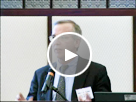The past few years have been an extraordinary time for policymakers. We have been very aggressive in providing support to the economy and it now appears that we are emerging from a deep and protracted recession. Economic activity expanded over the second half of 2009, suggesting that a recovery has begun. While we continue to receive encouraging news, growth is likely to be muted compared with the early stages of past recoveries. As a result, the unemployment rate is likely to decline over the near term at a very gradual pace, if at all.
In the labor market, employment has begun to expand. We hope this is the beginning of a sustained period of job growth. Total employment shrank by roughly 8 million jobs since the peak of the cycle, and the current unemployment rate of 9.7 percent remains unacceptably high.
At the regional level, here in the New York—New Jersey region, the labor market was not hit as hard as in many areas in the country, and the pace of job losses in our region has eased. Nevertheless, the unemployment rate in New York and New Jersey has risen to levels not seen in almost two decades.
In New York City, employment has typically recovered more than a year later than the recovery of national employment and has, in the past, been led by a recovery of Wall Street employment. Although Upstate New York has seen little overall job growth for the past several decades, job losses in this downturn were not as severe as losses for the nation, in part, because the upstate metro areas did not experience a boom-and-bust housing cycle. In addition, Puerto Rico, which is also part of our District, has experienced a considerably longer and deeper downturn than the mainland or this region.
Before I continue, it is important to explain the integral role of the Federal Reserve System in regional economies across the country. One of our key responsibilities here at the Federal Reserve Bank of New York is to connect the Federal Reserve System to Main Street across our District. Real activity takes place on Main Street in the form of the millions of decisions made every day by households and businesses around the country. When we talk to them, we learn how firms and consumers are experiencing the economy.
That essential insight from Main Street informs the policy decisions that we make in pursuit of our goals of stable prices, full employment and financial stability. Staying connected with Main Street is also important because the effectiveness of our policy actions is enhanced when private actors have a clear understanding of what our actions are intended to accomplish. For these complex policy decisions, the Federal Reserve System needs accurate and timely information on business and financial conditions, and the perspectives of participants in markets throughout the United States.
Economic conditions often differ in various parts of the country, and it is important that the Fed takes all of this into account when it formulates policy. This input is particularly important for the Second District of the Federal Reserve, where we sit today, because the forces that drive economic conditions here often do not mirror the forces driving other regional economies.
In order to monitor and understand the various aspects of local economic conditions, we utilize a number of different measures. Two of these measures we have developed here at the New York Fed—a survey of manufacturers and indexes of economic activity. We regularly produce the Beige Book and report information on local credit conditions. These measures supplement and extend the understanding gleaned from public data sources. We also seek input from regular meetings with several advisory groups representing different facets of the District’s economy—such as our Small Business, Upstate New York and Thrift Institutions panels—and from interactions with key academic researchers at local universities and public policy organizations.
We recognize that timely and accurate information about our region, which is highly valuable to us, can also help to reduce uncertainty and inform the economic and financial decisions of regional residents, businesses, communities and governments. To that end, we make our various regional measures and analysis available to the public through our website and a variety of outreach activities. These activities include making presentations on topics of current concern to business and community organizations throughout the District.
We welcome you here today to brief you on our views of the current state of activity and employment in the regional economy and to review the rich portfolio of resources that we make available to help monitor economic conditions across the region.














